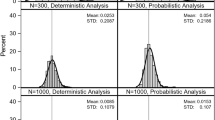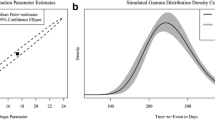Abstract
When making decisions under uncertainty, it is reasonable to choose the path that leads to the highest expected net benefit. Therefore, to inform decision making, decision-model-based health economic evaluations should always present expected outputs (i.e. the mean costs and outcomes associated with each course of action). In non-linear models such as Markov models, a single ‘run’ of the model with each input at its mean (a deterministic analysis) will not generate the expected value of the outputs. In a worst-case scenario, presenting deterministic analyses as the base case can lead to misleading recommendations. Therefore, the base-case analysis of a non-linear model should always be the means from a probabilistic analysis. In this paper, I explain why this is the case and provide recommendations for reporting economic evaluations based on Markov models, noting that the same principle applies to other non-linear structures such as partitioned survival models and individual sampling models. I also provide recommendations for conducting one-way sensitivity analyses of such models. Code illustrating the examples is provided in both Microsoft Excel and R, along with a video abstract and user guides in the electronic supplementary material.
Video abstract
Supplementary file 6 (MP4 20900 kb)


Similar content being viewed by others
References
Sackett DL, Rosenberg WM, Gray JA, Haynes RB, Richardson WS. Evidence based medicine: what it is and what it isn’t. BMJ (Clinical research ed). 1996;312(7023):71–2.
Paulden M. Calculating and interpreting ICERs and net benefit. PharmacoEconomics. 2020;38(8):785–807. https://doi.org/10.1007/s40273-020-00914-6.
Huygens C. De Ratiociniis in Ludo Aleae (The Value of all Chances in Games of Fortune; Cards, Dice, Wagers, Lotteries etc. Mathematically Demonstrated.). S. Keimer for T. Woodward, London. 1657 (English translation 1714). https://math.dartmouth.edu/~doyle/docs/huygens/huygens.pdf. Accessed 14 Apr 2020.
Raiffa H, Schlaifer R. Applied statistical decision theory. Boston: Harvard Business School; 1961.
Pratt J, Raiffa H, Schlaifer R. Introduction to statistical decision theory. Cambridge: Massachusetts Institute of Technology; 1995.
Arrow KJ, Lind RC. Uncertainty and evaluation of public investment decisions. Am Econ Rev. 1970;60(3):364–78.
Claxton K. The irrelevance of inference: a decision-making approach to the stochastic evaluation of health care technologies. J Health Econ. 1999;18(3):341–64.
Wilson EC. A practical guide to value of information analysis. Pharmacoeconomics. 2015;33(2):105–21. https://doi.org/10.1007/s40273-014-0219-x.
Claxton K, Cohen JT, Neumann PJ. When is evidence sufficient? Health Aff (Millwood). 2005;24(1):93–101.
Claxton K, Sculpher M, McCabe C, Briggs A, Akehurst R, Buxton M, et al. Probabilistic sensitivity analysis for NICE technology assessment: not an optional extra. Health Econ. 2005;14(4):339–47. https://doi.org/10.1002/hec.985.
R Core Team. R: A language and environment for statistical computing. R Foundation for Statistical Computing, Vienna, Austria. 2019. https://www.R-project.org/.
Wilson ECF. rrapidMarkov—a package for Markov models in R. 2021. https://github.com/EdCFWilson/rrapidmarkov. Accessed 8 Feb 21.
Warnes G, Bolker B, Lumley T. gtools: various R Programming Tools. R package version 3.8.2. 2020. https://CRAN.R-project.org/package=gtools. Accessed 14 Apr 2020.
National Institute for Health and Care Excellence. Guide to the methods of technology appraisal 2013. NICE, London. 2013. http://www.nice.org.uk/media/D45/1E/GuideToMethodsTechnologyAppraisal2013.pdf. Accessed 14 Apr 2020.
Fenwick E, Byford S. A guide to cost-effectiveness acceptability curves. Br J Psychiatry. 2005;187:106–8. https://doi.org/10.1192/bjp.187.2.106.
McCabe C, Paulden M, Awotwe I, Sutton A, Hall P. One-way sensitivity analysis for probabilistic cost-effectiveness analysis: conditional expected incremental net benefit. Pharmacoeconomics. 2020;38(2):135–41. https://doi.org/10.1007/s40273-019-00869-3.
Drummond M, Sculpher M, Claxton K, Stoddart G, Torrance G. Methods for the economic evaluation of health care programmes. 4th ed. Oxford: Oxford University Press; 2015.
Briggs A, Claxton K, Sculpher M. Decision modelling for health economic evaluation. Oxford: Oxford University Press; 2006.
Briggs A, Sculpher M, Claxton K. Chapter 4.1.1: Uncertainty and nonlinear models. Decision Modelling for Health Economic Evaluation. Oxford: Oxford University Press; 2006. p. 78.
Canadian Agency for Drugs and Technologies in Health. Guidelines for the ecoomic evaluation of health technologies: Canada. 4th Edition. 2017. https://www.cadth.ca/dv/guidelines-economic-evaluation-health-technologies-canada-4th-edition. Accessed 14 Apr 2020.
Pharmaceutical Benefits Advisory Committee. Guidelines for preparing submissions to the Pharmaceutical Benefits Advisory Committee (PBAC) v5.0. 2016. https://pbac.pbs.gov.au/. Accessed 14 Apr 2020.
Institute for Clinical and Economic Review. A guide to ICER’s methods for health technology assessment. 2018. http://icer-review.org/wp-content/uploads/2018/08/ICER-HTA-Guide_082018.pdf. Accessed 14 Apr 2020.
Institute for Clinical and Economic Review. ICER’s reference case for economic evaluations: Principles and rationale. 2018. http://icer-review.org/wp-content/uploads/2018/07/ICER_Reference_Case_July-2018.pdf. Accessed 14 Apr 2020.
Author information
Authors and Affiliations
Corresponding author
Ethics declarations
Funding
No sources of funding were used to conduct this study or prepare this manuscript.
Conflicts of interest
Edward CF Wilson has no conflicts of interest that are directly relevant to the content of this article.
Availability of data and material
Available as supplementary material.
Code availability
Available as supplementary material.
Authors’ contributions
ECFW was solely responsible for all aspects of creating this manuscript.
Supplementary Information
Below is the link to the electronic supplementary material.
Supplementary file 4 (MP4 72022 kb)
Supplementary file 5 (MP4 42802 kb)
Rights and permissions
About this article
Cite this article
Wilson, E.C.F. Methodological Note: Reporting Deterministic versus Probabilistic Results of Markov, Partitioned Survival and Other Non-Linear Models. Appl Health Econ Health Policy 19, 789–795 (2021). https://doi.org/10.1007/s40258-021-00664-2
Accepted:
Published:
Issue Date:
DOI: https://doi.org/10.1007/s40258-021-00664-2




